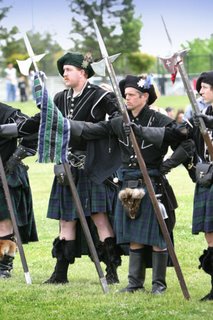


|

|
|
|
Home |
The Mil & Aero Blog
 Posted by John Keller The history of warfare is filled with accounts of pitched battles where one side or the other -- sometimes both at the same time -- are on the ragged edge between stand and fight, or retreat fast and to live and fight another day. Military commanders -- Robert E. Lee immediately comes to mind -- wrote that they could almost feel the opposing side ready to break and run under the onslaught of a determined infantry attack. It is that moment of decision -- fight or run -- that has been the key to many a military battle. Sometimes all it takes is one panicked soldier to start a stampede to the rear, creating an uncontrollable rout and likely defeat. It is for good reason that throughout history, military leaders have gone to great lengths to make their fighting forces stick to their guns. NCOs in the British Army of the 18th and early 19th centuries used to roam the firing lines just behind the infantry formations while carrying wicked-looking weapons called halberds, which had axe heads and a sharp pike in the middle (see accompanying photo). Anyone who ran would get the spear, and soldiers knew that to panic and run meant certain death. Commanders throughout the ages have done their best to induce opposing troops to panic and run. Stonewall Jackson ordered his men to "yell like furies," which they did, inventing the Rebel Yell in the process. Union soldiers used to roar like trains. Sometimes it worked, and sometimes it didn't. Today, U.S. military researchers are trying to do the Rebel Yell one better by uncovering the precise chemical scent of fear, according to a story on the Wired Danger Room blog entitled Pentagon Explores 'Human Fear' Chemicals; Scare-Sensors, 'Contagious' Stress in the Works? Now, the US Army is trying to track down and harness people's smell of fear. The military has backed a study on the "Identification and Isolation of Human Alarm Pheromones," which "focused on the Preliminary Identification of Steroids of Interest in Human Fear Sweat." The so-called "skydiving protocol" was the researchers' method of choice. Imagine a weapon that literally could spread the smell of fear among fighting forces on the ragged edge between fight and flight. It could tip the course of battle. It will take much more research to isolate these chemicals, and then to create the sensors, delivery systems, and protective clothing to get the fear weapon into the field. If the research comes to fruition, however, might international authorities outlaw fear weapons on the basis of chemical weapons treaties? I'm almost afraid to ask. << Home |
Welcome to the lighter side of Military & Aerospace Electronics. This is where our staff recount tales of the strange, the weird, and the otherwise offbeat. We could put news here, but we have the rest of our Website for that. Enjoy our scribblings, and feel free to add your own opinions. You might also get to know us in the process. Proceed at your own risk. 
John Keller is editor-in-chief of Military & Aerospace Electronics magazine, which provides extensive coverage and analysis of enabling electronic and optoelectronic technologies in military, space, and commercial aviation applications. A member of the Military & Aerospace Electronics staff since the magazine's founding in 1989, Mr. Keller took over as chief editor in 1995.  Courtney E. Howard is senior editor of Military & Aerospace Electronics magazine. She is responsible for writing news stories and feature articles for the print publication, as well as composing daily news for the magazine's Website and assembling the weekly electronic newsletter. Her features have appeared in such high-tech trade publications as Military & Aerospace Electronics, Computer Graphics World, Electronic Publishing, Small Times, and The Audio Amateur.
Courtney E. Howard is senior editor of Military & Aerospace Electronics magazine. She is responsible for writing news stories and feature articles for the print publication, as well as composing daily news for the magazine's Website and assembling the weekly electronic newsletter. Her features have appeared in such high-tech trade publications as Military & Aerospace Electronics, Computer Graphics World, Electronic Publishing, Small Times, and The Audio Amateur.
 John McHale is executive editor of Military & Aerospace Electronics magazine, where he has been covering the defense Industry for more than dozen years. During that time he also led PennWell's launches of magazines and shows on homeland security and a defense publication and website in Europe. Mr. McHale has served as chairman of the Military & Aerospace Electronics Forum and its Advisory Council since 2004. He lives in Boston with his golf clubs.
John McHale is executive editor of Military & Aerospace Electronics magazine, where he has been covering the defense Industry for more than dozen years. During that time he also led PennWell's launches of magazines and shows on homeland security and a defense publication and website in Europe. Mr. McHale has served as chairman of the Military & Aerospace Electronics Forum and its Advisory Council since 2004. He lives in Boston with his golf clubs.
Previous Posts
Archives
|
|||||
Internet gems
THE MAE WEBSITE AUTHORS ARE SOLELY RESPONSIBLE FOR THE CONTENT AND ACCURACY OF THEIR BLOGS, INCLUDING ANY OPINIONS THEY EXPRESS, AND PENNWELL IS NOT RESPONSIBLE FOR AND HEREBY DISCLAIMS ANY AND ALL LIABILITY FOR THE CONTENT, ITS ACCURACY, AND OPINIONS THAT MAY BE CONTAINED HEREIN. THE CONTENT ON THE MAE WEBSITE MAY BE DATED AND PENNWELL IS UNDER NO OBLIGATION TO PROVIDE UPDATES TO THE INFORMATION INCLUDED HEREIN.
|
||||||
|
|
Home | About Us | Contact Us | Corporate Website | Privacy Policy | Courage and Valor Foundation | Site Map
Also Visit: Laser Focus World | Vision Systems Design | Industrial Laser Solutions Copyright © 2007: PennWell Corporation, Tulsa, OK; All Rights Reserved. | Terms & Conditions | Webmaster |
Friday, January 25, 2008 7:55:00 AM EST
I was the drummer for the group and was actually in attendance at the event pictured, just behind the halberdiers.
Tuesday, July 15, 2008 2:17:00 PM EDT